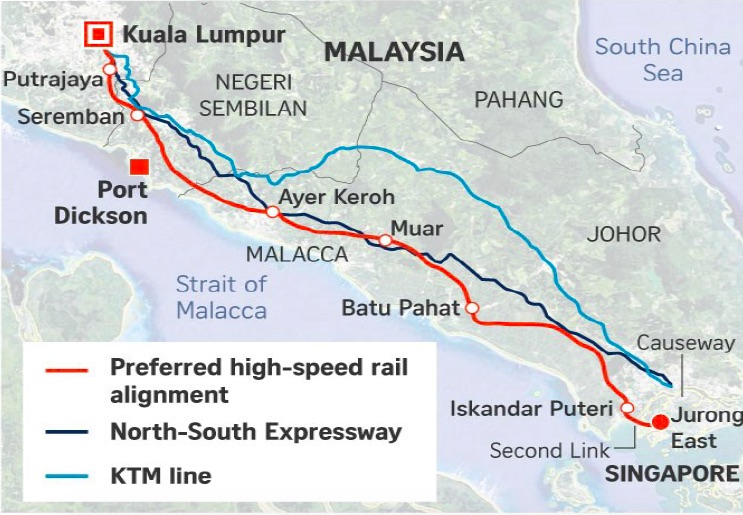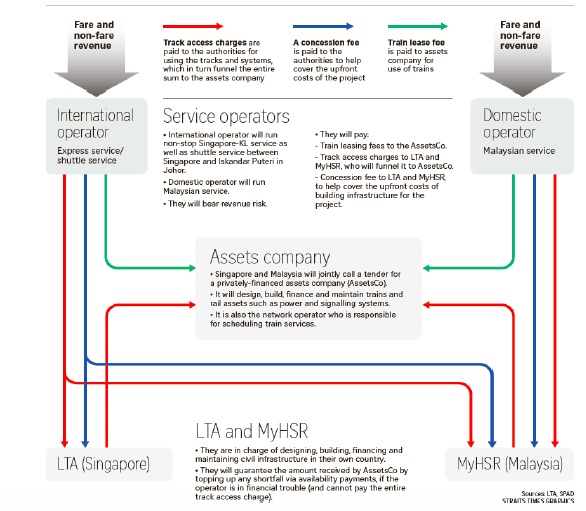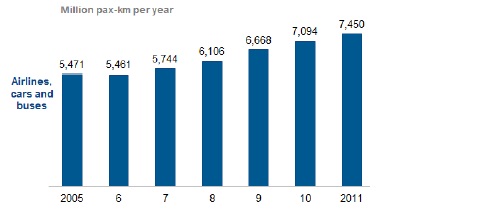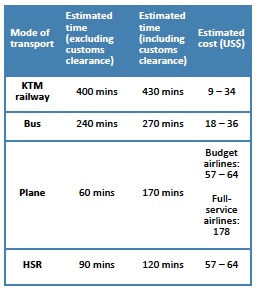7 July, 2017
This note serves as an update to two earlier notes dated August 2015 and January 2017 on the landmark Kuala Lumpur – Singapore High Speed Rail (the “HSR”). The attached schedules provide further insights on the rationale for the HSR and general structuring issues.
Background
This note serves as an update to two earlier notes dated August 2015 and January 2017 on the landmark Kuala Lumpur – Singapore High Speed Rail (the “HSR”). The attached schedules provide further insights on the rationale for the HSR and general structuring issues.
The HSR
In 2013, Singapore and Malaysia formally announced plans to develop the HSR. At around 350km, the HSR will connect Jurong East in Singapore with Bandar Malaysia (Kuala Lumpur) in Malaysia with six stops along the way (Putrajaya, Seremban, Ayer Keroh, Muar, Batu Pahat and Iskandar Puteri). Services are intended to run at speeds of up to 320 km/h and are planned to run four times an hour, including a non-stop service from Bandar Malaysia to Singapore.
Proposed HSR line from Kuala Lumpur to Singapore
Source: The Straits Times, “Historic agreement for Singapore-Kuala Lumpur high-speed rail line signed; service targeted to start by Dec 31, 2026” retrieved 4 January 2017 – http://www.straitstimes.com/singapore/historic-agreement-for-singapore-kuala-lumpur-high-speed-rail-line-signed-service-targeted
Presently, the HSR is expected to be completed in 2026. Construction is estimated to take place in the period of 2018 to 2025, followed by testing and commissioning in 2026.
An agreement for the implementation of the HSR was signed by Singapore and Malaysia on 13 December 2016 ("HSR Agreement"). Since then, the following project appointments have been made:
(a) A consortium comprising WSP Engineering Malaysia, Mott MacDonald Malaysia and Ernst & Young Advisory Services was appointed as Joint Development Partner in February 2017 to provide project management support and technical advice, develop technical and safety standards for the HSR, and assist with the preparation of the tender documents.
(b) AECOM Singapore was appointed by the Land Transport Authority of Singapore ("LTA") in February 2017 to provide architectural, engineering and other design services for the infrastructure on the Singapore side of the HSR.
(c) MyHSR Corporation of Malaysia ("MyHSR") appointed a joint venture of Systra and Meinhardt in May 2017 as reference design consultants for infrastructure work on the Malaysia side of the HSR.
If successful, the HSR will be the first high speed railway in South East Asia.
The HSR and existing travel modes
Singapore and Malaysia are presently very well-connected by land, air and sea, and the HSR must be viewed as a complementary addition to the existing infrastructure as opposed to filling in a complete vacuum.
(a) Land – Singapore and Johor are connected by the causeway and the second link. Numerous public and private bus services use these routes and continue along the North-South Highway to Kuala Lumpur.
Singapore and Malaysia are also connected by a railway service operated by Malaysian Railway (“KTM”), and there are plans to construct a Rapid Transit System connecting Woodlands North (Singapore) and Johor Bahru Sentral (Malaysia) which will replace the above mentioned railway service.
(b) Air – There are full-service airlines and budget airlines plying the Kuala Lumpur – Singapore route.
(c) Sea – There are sea crossings between Singapore and Johor, as well as pleasure cruises between Singapore and various Malaysian ports.
Notwithstanding the existing plethora of options for travellers, the HSR offers an attractive transportation proposition, and is also a political, economic and social development tool. Please refer to Schedule 1 for further details on the rationale for the construction of the HSR.
Project structure
The key aspects of the structuring of the HSR Project are summarised below.
- MyHSR and LTA will develop, construct and maintain the civil infrastructure and stations within their own countries including a 25m high bridge over the Johor Straits.
- Land for both termini will need to be acquired. Singapore has chosen to situate its terminus on land which is currently occupied by the Jurong Country Club and the Raffles Country Club, while Malaysia's choice of terminus location is a plot of land in Sungei Besi that was previously occupied by the Royal Malaysian Air Force.
- Customs, Immigration and Quarantine ("CIQ") facilities will be located at Bandar Malaysia, Iskandar Puteri and Singapore, and it is anticipated that passengers will only need to clear CIQ once as both countries will locate their CIQ facilities at the above areas.
- Tenders will be called from the private sector by MyHSR and LTA for an asset company to design, build, finance and maintain the rail related assets (power and signalling systems as well as to oversee scheduling) and two operating companies to operate the express and domestic train services.
- The Malaysian domestic HSR service will be operated separately from the express non-stop HSR service between Kuala Lumpur and Singapore, which will allow Malaysia to have complete autonomy over the domestic service and the ability to tailor it to meet local needs. In scheduling the train services, the international operator will have priority over the domestic operator.
- The HSR fares will be set by the private operators. The HSR fares are required to be benchmarked against air fares, but are not anticipated to be significantly regulated by either government.
- The operators will be expected to bear revenue risk, pay train leasing fees to the asset company, pay track access charges and concession fees to MyHSR and LTA.
- MyHSR and LTA will retain the concession fees to offset the costs of the civil infrastructure and funnel the track access charges to the asset company.
- MyHSR and LTA will guarantee the revenue of the asset company by topping up shortfalls through availability payments.
Please refer to Schedule 2 for more details on the key issues concerning the HSR project structure.
International interest
The HSR has generated a significant amount of international interest, with companies from China, France, Germany, Japan and South Korea expressing interest. A total of 98 submissions were received in response to the Request for Information exercise called in October 2015, the bulk of which were primarily European companies and consortia.
Time frame
The indicative schedule for the project is as follows:
|
Event |
Year |
|
Briefing for companies interested in the tender for the systems package |
July 2017 |
|
Acquisition of land for the Malaysian portion of the HSR |
2017, 3Q |
|
Issue of the tender for the systems package (namely the rolling stock and rail tracks) |
2017, 4Q |
|
Award of the tender for the systems package |
2018, 4Q |
|
Construction of the HSR |
2018 – 2025 |
|
Issue of the tender for the international and domestic (Malaysian) operations packages |
2023, 4Q |
|
Testing and commissioning of the HSR Commencement of HSR operations |
2026 |
Conclusion
The HSR currently occupies a Goldilocks sweet-spot, as it connects two major cities at an ideal distance of 350km that will bring substantial cost and time savings.
That being said, cross-border railway projects are complex and challenging, as clearly evinced by the lengthy period of time that both countries have been at the drawing board. This year, we anticipate more light to be shed on the project structure for potential tenderers to consider.
Who pays for what
How the Kuala Lumpur – Singapore High Speed Rail will be financed
Please click on the image to enlarge.
Source: The Straits Times, “Who pays for what” retrieved 2 May 2017 – http://www.straitstimes.com/sites/default/files/attachments/2016/12/14/st_20161214_vnhsrbig_2807202.pdf
Our select rail experience
- Sojitz Corporation on the construction contracts and arrangements relating to the Western Dedicated Freight Corridor freight railway linking Delhi and Mumbai
- On three different schemes for the Channel Tunnel High Speed Rail Link:
- Scheme 1: the British Railways Board on its original proposed joint venture with two leading private sector developers/ contractors to jointly build, own and operate a high capacity link between London and the Channel Tunnel
- Scheme 2: a major international developer and engineering group as shareholder in and contractor to the development company awarded the franchise for the rail link
- Scheme 3: the restructuring of the arrangements for Scheme 2
- RFF and the French Government on the tendering of the Tours-Bordeaux high speed rail concession project (LGV SEA) (€7.8bn))
- The UK Department for Transport (the "DfT") on the £7bn Intercity Express Programme for the procurement of high speed railway stock and an associated infrastructure upgrade
- A member of the joint venture appointed to construct part of the Taiwan High Speed Rail
- The general contractor consortium on the procurement and delivery of two lots of the ICE (high speed railway) track from Cologne – Frankfurt
- A bidding consortium in connection with the procurement of the Perpignan Figueres HSL concession (€1.1bn)
- The shareholders on the restructuring of the €1.32bn high speed rail link from Amsterdam to the Belgian border
- On the acquisition of the Arlanda High Speed Rail project in Sweden
- The Hong Kong MTRC in relation to numerous projects, including developing the contractual structure and contract documents for the construction of the rail link to Hong Kong Airport
- PT Sarana Multi Infrastruktur (Persero) on its feasibility arrangements for the Soekarno Hatta International Airport to Manggarai Rail Link PPP project in Jakarta
- Asian Development Bank on the development of a rail-based mass rapid transit system in Bangalore, India
- Energy Resources Rail LLC as project sponsors on all aspects of the Ukhaa Khudag-Gashuun Sukhait railway project in Mongolia including the railway construction packages
- The Hong Kong MTRC on the development of their forms of contract for the Hong Kong Quarry Bay Relief Line and Tseung Kwan O Relief Extension projects and project issues during implementation
Schedule 1
Rationale for the HSR
To understand the rationale for the construction of the HSR, the HSR must firstly be viewed against a larger political, economic and social background, secondly against current demand, and thirdly against the other existing transportation options.
The HSR and its political, economic and social context
Political perspective
Singapore and Malaysia have historically been closely related, and the HSR is seen as a symbol of strengthened diplomatic ties. The Leaders' Retreat is an annual platform between the two countries' Prime Ministers that has traditionally yielded major bilateral agreements, and the HSR was first announced at the 2013 Leaders' Retreat with the HSR Agreement being signed at the 2016 Leaders' Retreat.
From a broader ASEAN perspective, the ASEAN member states have repeatedly affirm their desire to move towards greater regional integration and connectivity. For example, there are plans to establish an ASEAN Economic Community that would allow for free movement of goods, services and labour. The HSR could prove to be a showpiece of this wider ASEAN goal.
Economic perspective
The HSR would make day trips between Kuala Lumpur and Singapore even more convenient, be it for business or leisure, and thus act as a catalyst for economic growth.
For the Malaysian government in particular, the HSR is a key piece of the Economic Transformation Programme that targets to raise the GNI per capita to at least US$15,000 by 2020. The Malaysian railway stations will be strategically located at areas which have been targeted by the government for economic development. For example, Seremban is currently already a major satellite city for Kuala Lumpur and is positioned to be a technology hub. The Malaysia government anticipates that the transformational effects will filter down into each of these regions and their peripheries.
Social perspective
The HSR is an important infrastructure project that would improve connectivity and accessibility for people living near the stations.
For Singapore, the HSR also forms part of a larger urban development plan to develop regional centres outside of the central business district. For many years, land-scarce Singapore has faced transportation and congestion issues in the central areas and the government is trying to resolve this issue by dispersing human traffic. As such, the Singapore HSR terminus will be located in Jurong East – once a traditionally industrial area with residential pockets, that is being developed into and revitalised as a mixed-use self-contained urban district (the Jurong Lake District).
The HSR and current demand
The demand for Kuala Lumpur-Singapore trips appears to be high. The Kuala Lumpur-Singapore route has seen strong growth in passenger-km of travel, with the total travel market growing from 5.47 million passenger-km in 2005 to 7.45 million passenger-km in 2011.
Base transport demand in HSR corridor (only relevant routes)
Source: Malaysian Land Public Transport Commission, “Projects – High Speed Rail”, retrieved 22 July 2015 − http://www.spad.gov.my/projects/high-speed-rail
Present demand also exceeds the capacity of the existing infrastructure. For instance, demand for the use of the causeway, one of the two bridges connecting Johor Bahru and Singapore, exceeds capacity by 33%. The market for Kuala Lumpur-Singapore trips is expected to continue growing at a comparable rate to the GDP growth of Malaysia and Singapore, at an average of 3 to 5%. In the long run, as the market matures, the growth rate might slow down. Nevertheless, average growth is still expected to hover around 3.2% from 2011 to 2060, with a market of 251 million passenger trips by 2060.
Hence, it appears that the HSR would add another option to meet increasing demand.
The HSR and its competitive edge
Ticket sales are partially dependent on the HSRʼs advantages vis-à-vis its competitors, especially in terms of price and time. The HSRʼs closest competitors appear to be budget airlines and buses.
Presently, single-trip tickets for the HSR are anticipated to cost around US$57-US$64. This is roughly the same price range for a single-trip flight on a budget airline, but is possibly a more comfortable ride and a faster one (when the boarding and security checks are factored in). Budget airlines would nevertheless retain an advantage in respect of transit passengers as the HSR termini are located far from their respective airports.
Buses have a price advantage over the HSR, and have the flexibility to pick up and drop off customers at a greater variety of locations. However, they are significantly slower than the HSR.
Estimated travel time and cost for a single-way trip between Kuala Lumpur and Singapore
Schedule 2
Key issues concerning the HSR Project Structure
Some key issues arising out of the anticipated HSR Project structure include:
Relationship and synergies between the asset and operating companies
- it appears that the asset and two operating companies are being procured separately
- it would be critical to understand the contractual and working nexus between the three companies (i.e. technical interfacing and contractual relationship) and the infrastructure provider (MyHSR and LTA). This understanding is crucial to the bidding strategy for both the asset and operating companies as the companies will be expected to work together to implement and operate the project over the term of the project
- the ability for the companies to seek legal recourse against each other for any failure to fulfil respective obligations will also need to be understood. For example, how a delay in train maintenance or a signal systems failure will affect operations and operating revenue and how that will be compensated as between the asset and the operating companies
- one market trend is for the asset company to be a pure financing vehicle that allows direct recourse between the operator and key subcontractors of the asset company
Level of risk transfer to the asset and operating companies
- the bankability of the asset company structure and risk allocation will require careful study as the asset company will presumably need to rely on financing in order to fund the asset company's obligations
- both MyHSR and LTA are sub-sovereign entities and the extent to which their respective balance sheets can absorb the guarantee payments to the asset company will be scrutinised. A similar question also arises with respect to the compensation regime on any early termination or nationalisation of the HSR Project
- as the guarantee to the asset company is structured in the form of an availability payment, this presumably means that deductions will be levied against the availability payment for any shortfall in availability. This deduction regime will have to studied carefully including how it interfaces with any non-availability caused by the failure of the infrastructure assets
- it will be important to understand how revenue risk will be transferred to the operating company i.e. will it be on the basis of a proposed tariff measured against fees bid for track access and concessions charges and whether the proposed tariff will be subject to approval / regulation by MyHSR and LTA
Dynamics of evaluation with ownership resting jointly between MyHSR and LTA
- the project decision making process has been organised such that a consensus must be reached for any decisions (i.e. neither country has a veto on decisions)
- Singapore and Malaysia will have different priorities on some key issues (e.g. strong local content priorities in Malaysia as opposed to best value procurement approach in Singapore as well as any possible preference from Malaysia over the domestic HSR system over the express system) in the evaluation process and an understanding of how these issues will be evaluated will be key
- strong feedback should be provided to ensure that clear and transparent evaluation criteria for each of the tenders are made available
Procurement and execution time frames bearing in mind the project schedule
- an aggressive time frame will likely require the asset and operating company tenders to be run concurrently and this will create difficulties in terms of measuring the scope and quality of the operating company tenders against an arguably moving target of asset company tenders the contents of which will be unknown to the operating company tenderers
- the strategy of the financing structure will likely require tenderers for the operating company to submit competitive ticket prices against high concession fees and track access charges
- the asset company on the other hand will need to tender competitively on a value proposition based on the asset price and thus minimising any availability payment on the part of MyHSR and LTA
For further information, please contact:
Alex Wong, Partner, Hogan Lovells
alex.wong@hoganlovells.com









